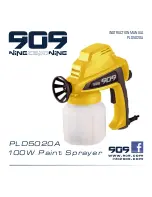
5
Measuring the Viscosity
To measure the viscosity of
the spray material follow these
instructions (refer Fig 1):
1. Dip the viscosity test cup
completely into the spray
material to be used.
2. Hold the test cup up and
measure the time (in seconds)
until the liquid empties (stop
running) out of the viscosity cup.
3. Compare the measured “runout time” with the Viscosity Table
to establish the required viscosity
Preparing for Operation
Ensure you check and follow the below recommended steps
before using your Paint Sprayer
1. Before connecting your paint sprayer to the mains supply,
ensure that the supply voltage is identical with the value given
on the rating label (on the side of the spray gun).
Note: To reduce the risk of electric shock, the manufacturer
recommends the use of a residual current of 30mA or less at
all times.
2. Dilute the spray material according to the viscosity table.
3. Place the paint pot on a sheet of paper and fill it with the
prepared spray material.
NOTE: It is strongly
recommended to fill the paint pot
through a fine strainer/gauze to
filter the paint.
WARNING: Do not operate the
spray gun without spray material
in the paint pot.
4. Position the spray gun on the paint pot and turn the container
to the right until the container fits tightly (refer Fig 2)
NOTE: Ensure you undertake a test spray with the unit before
beginning your spraying task on your work piece.
Operation
Spray Technique
Before using your paint sprayer, read the following tips for
spraying techniques:
• Cover areas that are not to be sprayed. When working keep in
mind that wind, for example, may transport paint mist over
great distances and cause damage.
• Test the spray gun on cardboard or a similar surface to find the
correct setting before you start spraying your work piece.
• When spraying, hold the spray gun in a horizontal position.
Use the flexible nozzle extension for spraying upwards (e.g. a
ceiling) or downwards (e.g. an unhinged door laid on the floor).
• The spray movement should come from the arm, not just from
the wrist. This ensures that a uniform distance is maintained
between the spray gun and the spray surface during the spray
operation (refer Fig 3).
• To achieve optimal spray results, spray back and forth over the
surface (refer Fig 4).
Starting the Paint Sprayer
1. To start the paint sprayer, press the On/Off trigger switch.
2. To stop the Paint Sprayer, release the On/Off Trigger switch
Before using the paint Sprayer on your work piece make sure
you undertake a test spray on a scrap piece of material.
Using the Paint Volume Control Dial
The paint Volume Control dial is
used to increase or decrease the
flow of paint being sprayed from
the Paint Sprayer. For Larger
surface spraying, the maximum
flow is recommended. For
smaller surface spraying, the
minimum flow is recommended.
Note: Before using the paint
Sprayer on your work piece make
sure you undertake a test spray
on a scrap piece of material.
1. To increase the paint flow, turn the Paint Volume Control dial
to the left. (refer Fig 5).
Fig. 1
Fig. 4
Fig. 3
Fig. 2
Fig. 5
Summary of Contents for PLD5020A
Page 1: ...INSTRUCTION MANUAL PLD5020A PLD5020A 100W Paint Sprayer ...
Page 8: ......


























